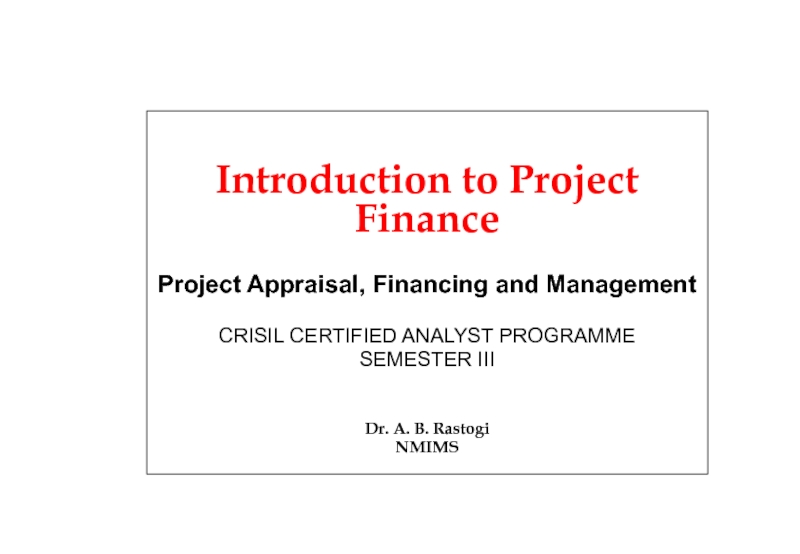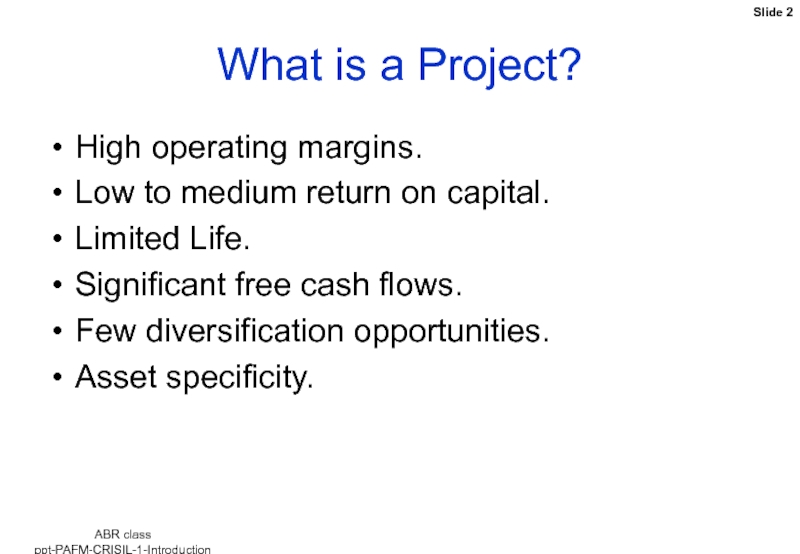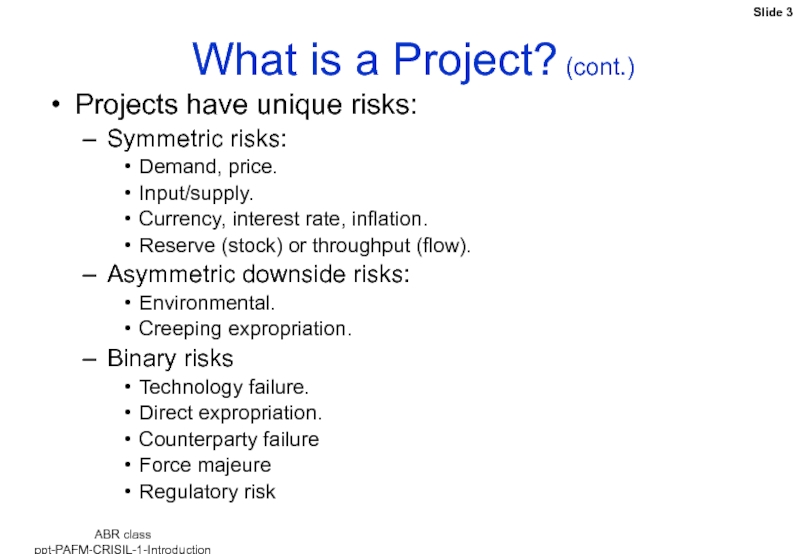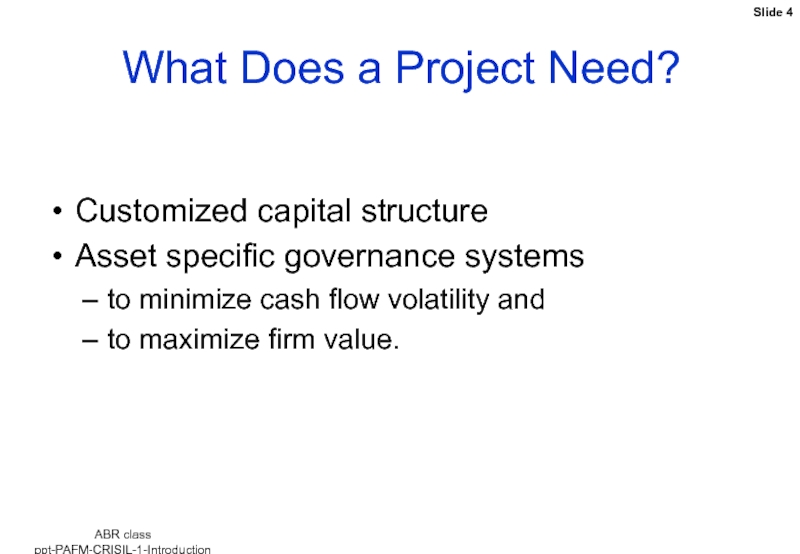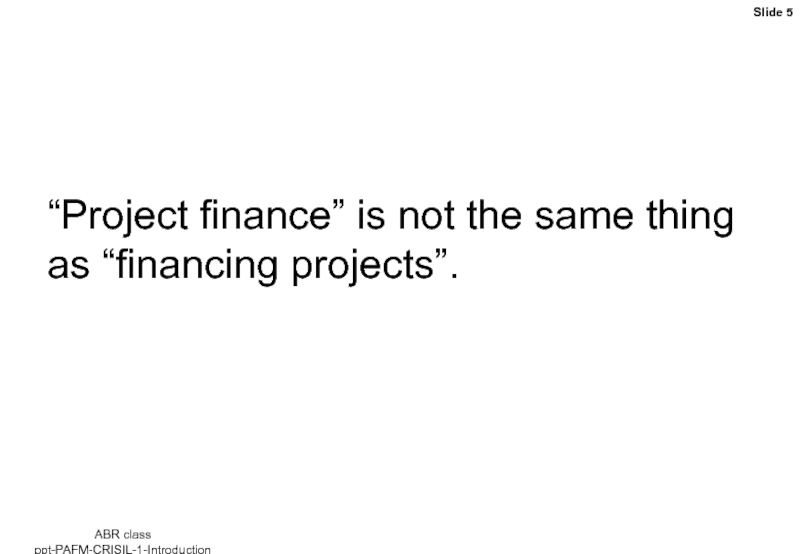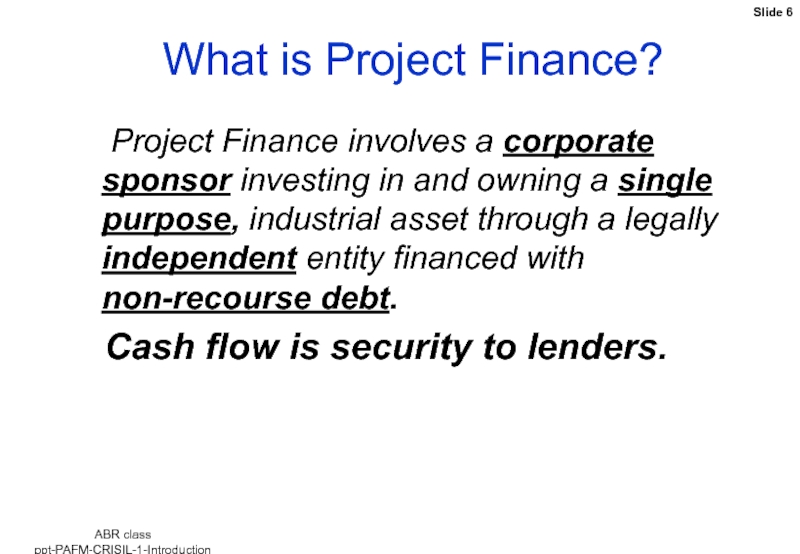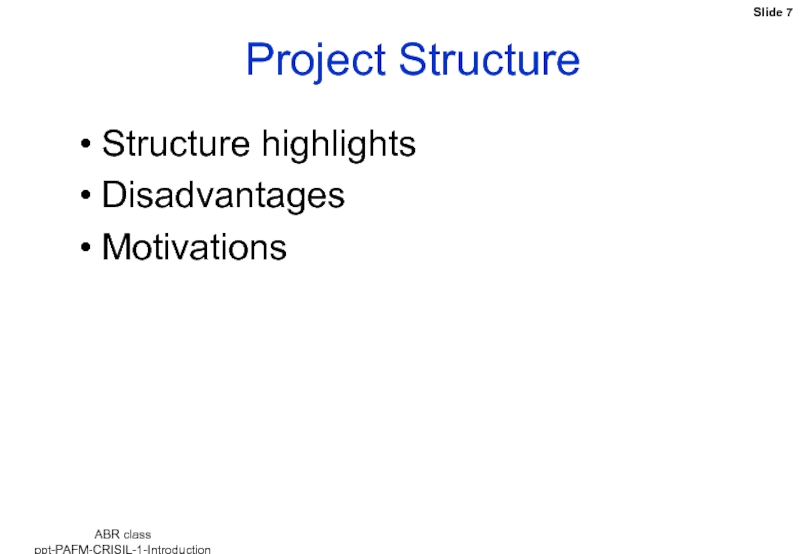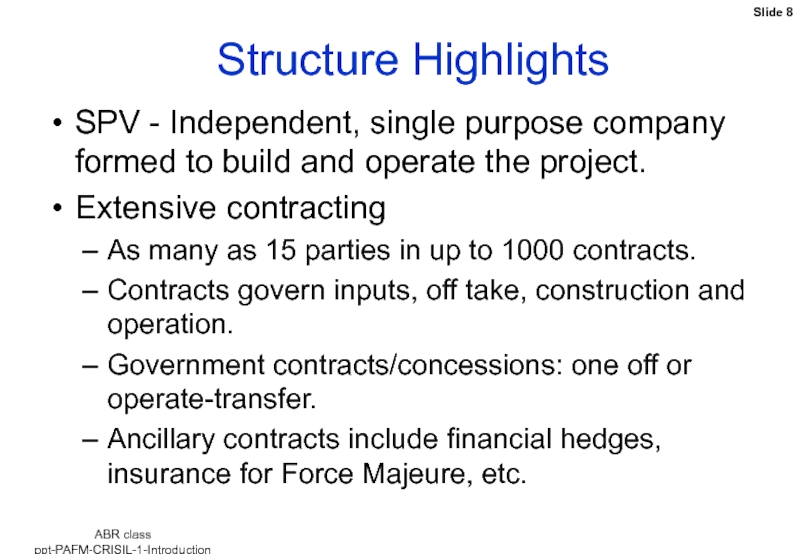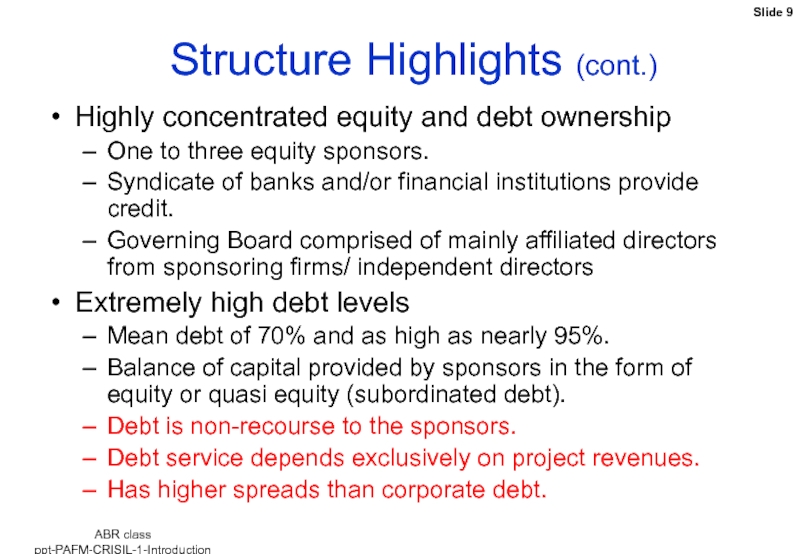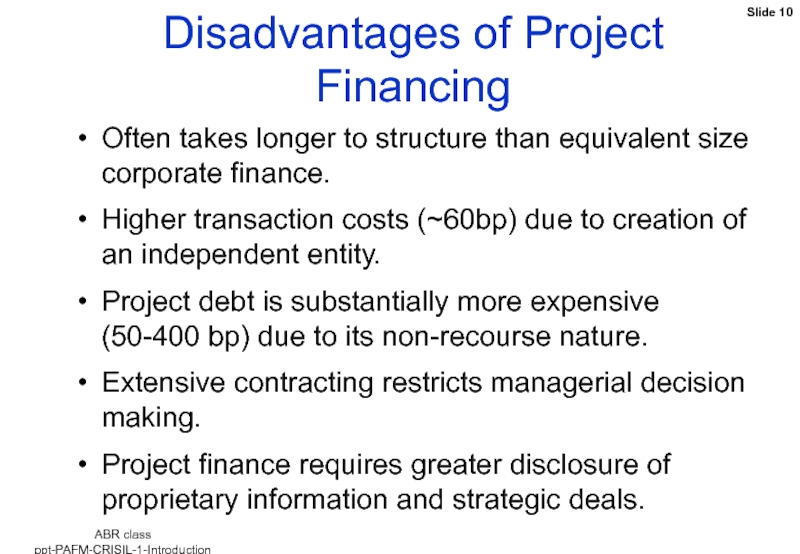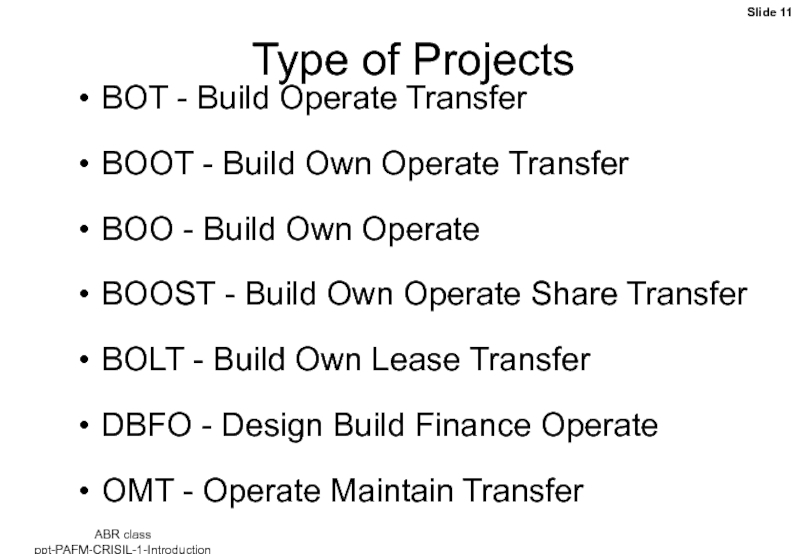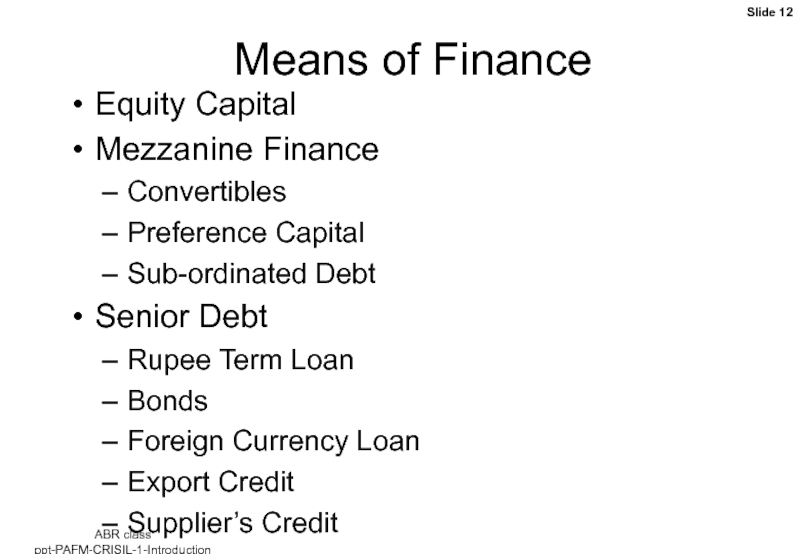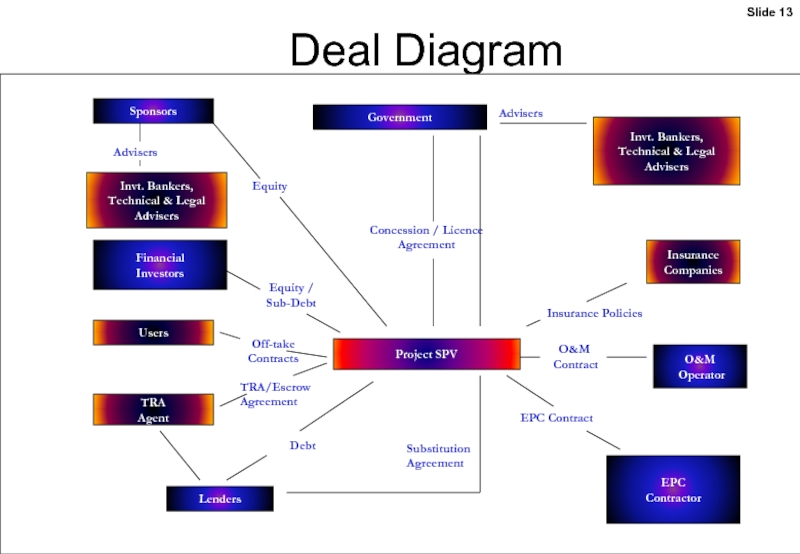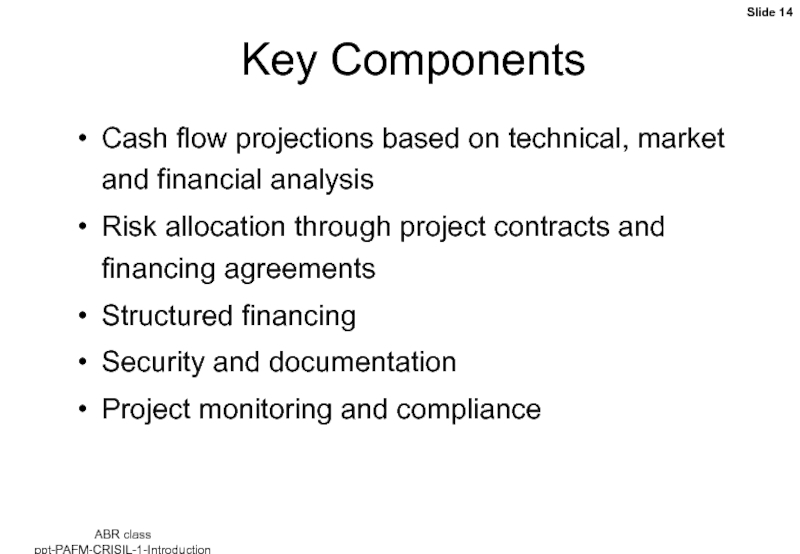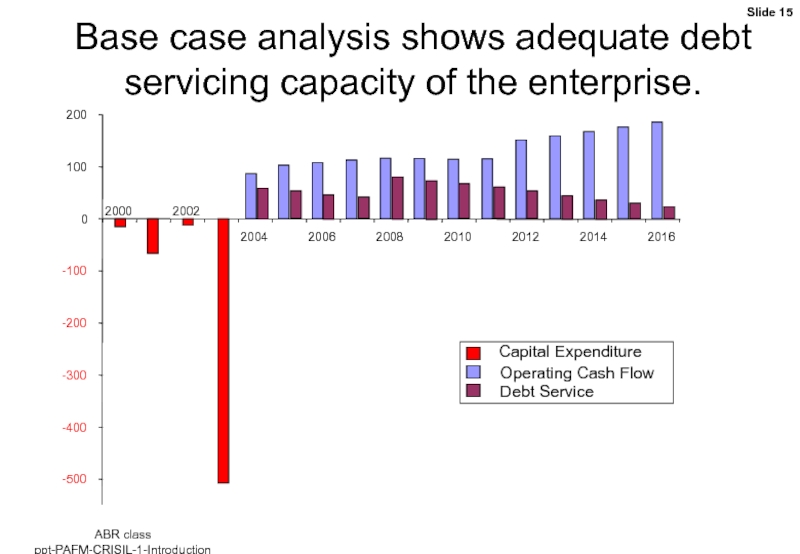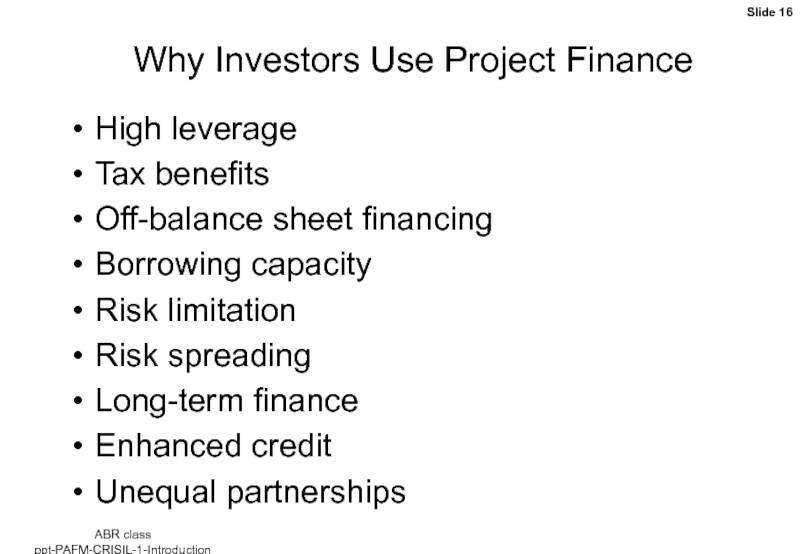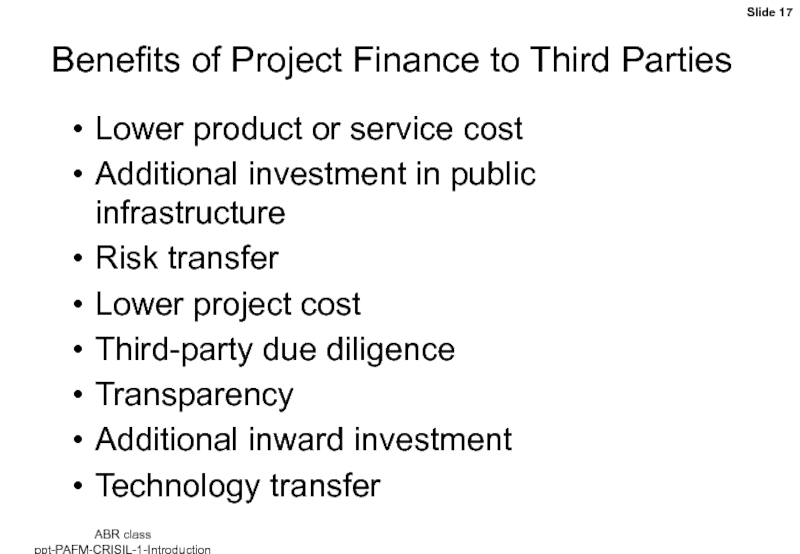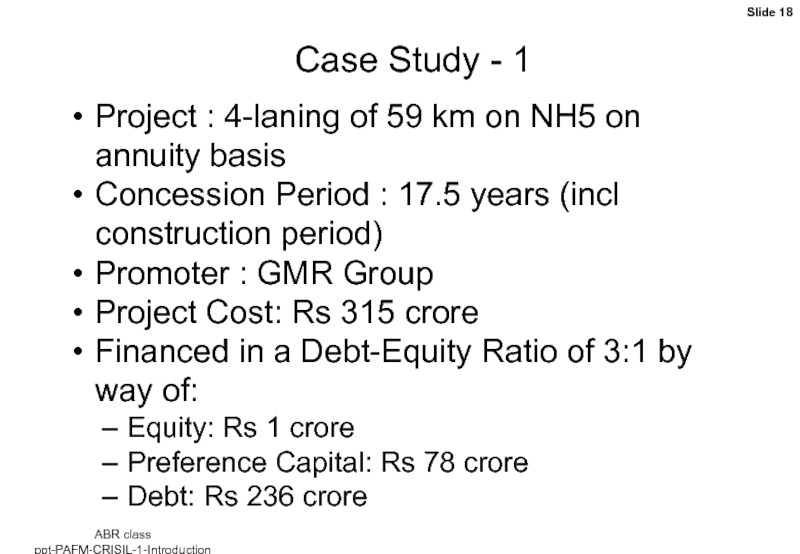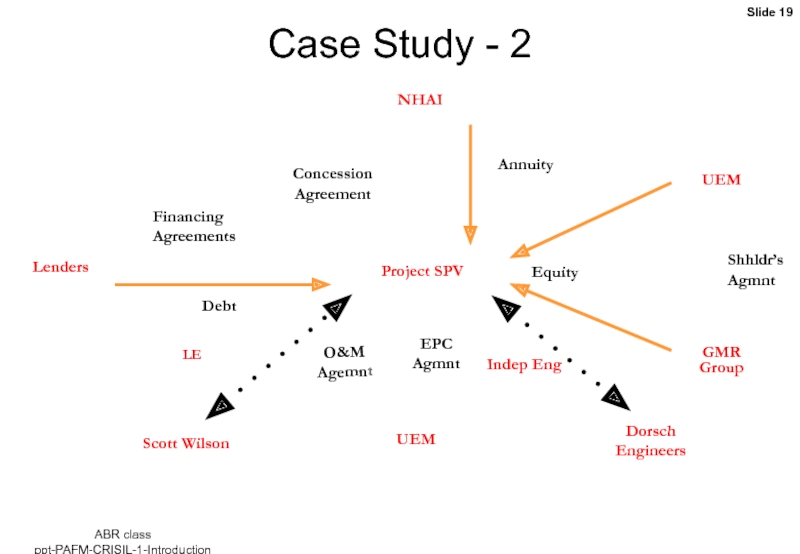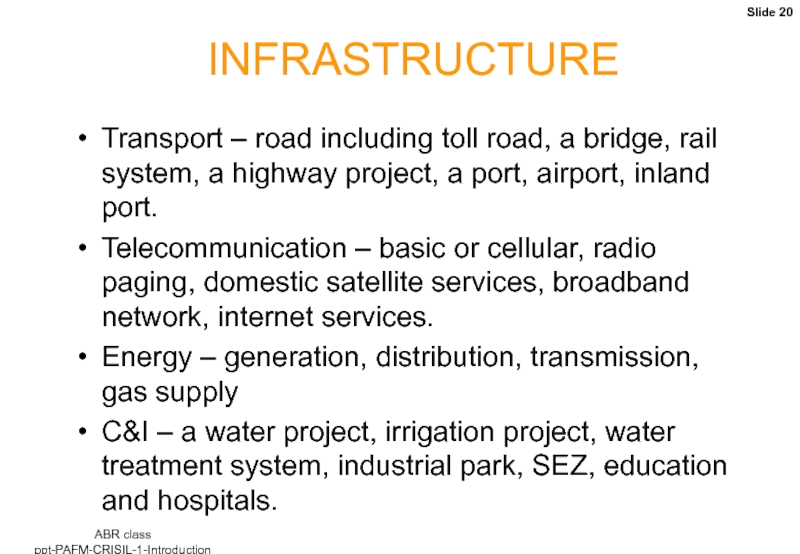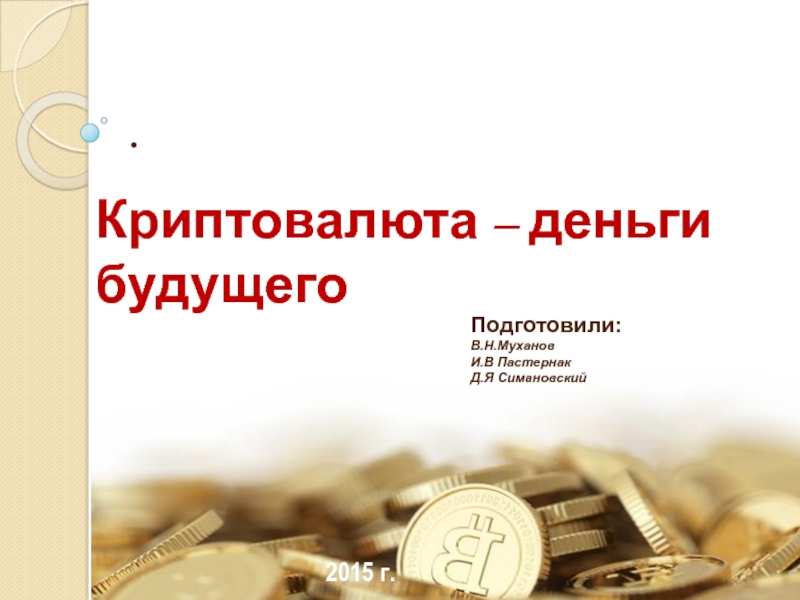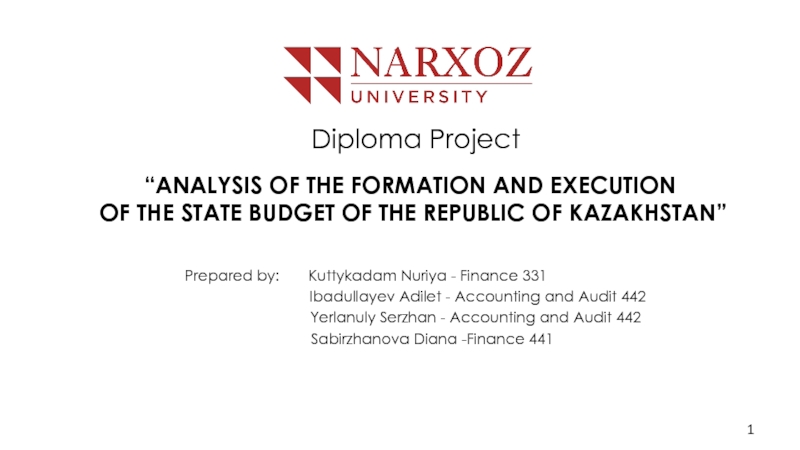III
Dr. A. B. Rastogi
NMIMS
- Главная
- Разное
- Дизайн
- Бизнес и предпринимательство
- Аналитика
- Образование
- Развлечения
- Красота и здоровье
- Финансы
- Государство
- Путешествия
- Спорт
- Недвижимость
- Армия
- Графика
- Культурология
- Еда и кулинария
- Лингвистика
- Английский язык
- Астрономия
- Алгебра
- Биология
- География
- Детские презентации
- Информатика
- История
- Литература
- Маркетинг
- Математика
- Медицина
- Менеджмент
- Музыка
- МХК
- Немецкий язык
- ОБЖ
- Обществознание
- Окружающий мир
- Педагогика
- Русский язык
- Технология
- Физика
- Философия
- Химия
- Шаблоны, картинки для презентаций
- Экология
- Экономика
- Юриспруденция
Introduction to Project Finance. Project Appraisal, Financing and Management презентация
Содержание
- 1. Introduction to Project Finance. Project Appraisal, Financing and Management
- 2. What is a Project? High operating margins.
- 3. What is a Project? (cont.) Projects have
- 4. What Does a Project Need? Customized capital
- 5. “Project finance” is not the same thing as “financing projects”.
- 6. What is Project Finance? Project Finance involves
- 7. Project Structure Structure highlights Disadvantages Motivations
- 8. Structure Highlights SPV - Independent, single purpose
- 9. Structure Highlights (cont.) Highly concentrated equity and
- 10. Disadvantages of Project Financing Often takes longer
- 11. Type of Projects BOT - Build Operate
- 12. Means of Finance Equity Capital Mezzanine Finance
- 13. Financing Infrastructure Projects Deal Diagram Government Project SPV
- 14. Key Components Cash flow projections based on
- 15. Base case analysis shows adequate debt servicing
- 16. Why Investors Use Project Finance High leverage
- 17. Benefits of Project Finance to Third Parties
- 18. Case Study - 1 Project : 4-laning
- 19. Case Study - 2 Project SPV
- 20. INFRASTRUCTURE Transport – road including toll road,
- 21. Thank you
Слайд 1
Introduction to Project Finance
Project Appraisal, Financing and Management
CRISIL CERTIFIED ANALYST PROGRAMME
SEMESTER
Слайд 2What is a Project?
High operating margins.
Low to medium return on capital.
Limited
Life.
Significant free cash flows.
Few diversification opportunities.
Asset specificity.
Significant free cash flows.
Few diversification opportunities.
Asset specificity.
Слайд 3What is a Project? (cont.)
Projects have unique risks:
Symmetric risks:
Demand, price.
Input/supply.
Currency,
interest rate, inflation.
Reserve (stock) or throughput (flow).
Asymmetric downside risks:
Environmental.
Creeping expropriation.
Binary risks
Technology failure.
Direct expropriation.
Counterparty failure
Force majeure
Regulatory risk
Reserve (stock) or throughput (flow).
Asymmetric downside risks:
Environmental.
Creeping expropriation.
Binary risks
Technology failure.
Direct expropriation.
Counterparty failure
Force majeure
Regulatory risk
Слайд 4What Does a Project Need?
Customized capital structure
Asset specific governance systems
to minimize
cash flow volatility and
to maximize firm value.
to maximize firm value.
Слайд 6What is Project Finance?
Project Finance involves a corporate sponsor investing in
and owning a single purpose, industrial asset through a legally independent entity financed with non-recourse debt.
Cash flow is security to lenders.
Cash flow is security to lenders.
Слайд 8Structure Highlights
SPV - Independent, single purpose company formed to build and
operate the project.
Extensive contracting
As many as 15 parties in up to 1000 contracts.
Contracts govern inputs, off take, construction and operation.
Government contracts/concessions: one off or operate-transfer.
Ancillary contracts include financial hedges, insurance for Force Majeure, etc.
Extensive contracting
As many as 15 parties in up to 1000 contracts.
Contracts govern inputs, off take, construction and operation.
Government contracts/concessions: one off or operate-transfer.
Ancillary contracts include financial hedges, insurance for Force Majeure, etc.
Слайд 9Structure Highlights (cont.)
Highly concentrated equity and debt ownership
One to three equity
sponsors.
Syndicate of banks and/or financial institutions provide credit.
Governing Board comprised of mainly affiliated directors from sponsoring firms/ independent directors
Extremely high debt levels
Mean debt of 70% and as high as nearly 95%.
Balance of capital provided by sponsors in the form of equity or quasi equity (subordinated debt).
Debt is non-recourse to the sponsors.
Debt service depends exclusively on project revenues.
Has higher spreads than corporate debt.
Syndicate of banks and/or financial institutions provide credit.
Governing Board comprised of mainly affiliated directors from sponsoring firms/ independent directors
Extremely high debt levels
Mean debt of 70% and as high as nearly 95%.
Balance of capital provided by sponsors in the form of equity or quasi equity (subordinated debt).
Debt is non-recourse to the sponsors.
Debt service depends exclusively on project revenues.
Has higher spreads than corporate debt.
Слайд 10Disadvantages of Project Financing
Often takes longer to structure than equivalent size
corporate finance.
Higher transaction costs (~60bp) due to creation of an independent entity.
Project debt is substantially more expensive (50-400 bp) due to its non-recourse nature.
Extensive contracting restricts managerial decision making.
Project finance requires greater disclosure of proprietary information and strategic deals.
Higher transaction costs (~60bp) due to creation of an independent entity.
Project debt is substantially more expensive (50-400 bp) due to its non-recourse nature.
Extensive contracting restricts managerial decision making.
Project finance requires greater disclosure of proprietary information and strategic deals.
Слайд 11Type of Projects
BOT - Build Operate Transfer
BOOT - Build Own Operate
Transfer
BOO - Build Own Operate
BOOST - Build Own Operate Share Transfer
BOLT - Build Own Lease Transfer
DBFO - Design Build Finance Operate
OMT - Operate Maintain Transfer
BOO - Build Own Operate
BOOST - Build Own Operate Share Transfer
BOLT - Build Own Lease Transfer
DBFO - Design Build Finance Operate
OMT - Operate Maintain Transfer
Слайд 12Means of Finance
Equity Capital
Mezzanine Finance
Convertibles
Preference Capital
Sub-ordinated Debt
Senior Debt
Rupee Term Loan
Bonds
Foreign Currency
Loan
Export Credit
Supplier’s Credit
Export Credit
Supplier’s Credit
Слайд 14Key Components
Cash flow projections based on technical, market and financial analysis
Risk
allocation through project contracts and financing agreements
Structured financing
Security and documentation
Project monitoring and compliance
Structured financing
Security and documentation
Project monitoring and compliance
Слайд 15Base case analysis shows adequate debt servicing capacity of the enterprise.
-500
-400
-300
-200
-100
0
100
200
2000
2002
2004
2006
2008
2010
2012
2014
2016
Слайд 16Why Investors Use Project Finance
High leverage
Tax benefits
Off-balance sheet financing
Borrowing capacity
Risk limitation
Risk
spreading
Long-term finance
Enhanced credit
Unequal partnerships
Long-term finance
Enhanced credit
Unequal partnerships
Слайд 17Benefits of Project Finance to Third Parties
Lower product or service cost
Additional
investment in public infrastructure
Risk transfer
Lower project cost
Third-party due diligence
Transparency
Additional inward investment
Technology transfer
Risk transfer
Lower project cost
Third-party due diligence
Transparency
Additional inward investment
Technology transfer
Слайд 18Case Study - 1
Project : 4-laning of 59 km on NH5
on annuity basis
Concession Period : 17.5 years (incl construction period)
Promoter : GMR Group
Project Cost: Rs 315 crore
Financed in a Debt-Equity Ratio of 3:1 by way of:
Equity: Rs 1 crore
Preference Capital: Rs 78 crore
Debt: Rs 236 crore
Concession Period : 17.5 years (incl construction period)
Promoter : GMR Group
Project Cost: Rs 315 crore
Financed in a Debt-Equity Ratio of 3:1 by way of:
Equity: Rs 1 crore
Preference Capital: Rs 78 crore
Debt: Rs 236 crore
Слайд 19Case Study - 2
Project SPV
NHAI
Lenders
UEM
UEM
GMR Group
Dorsch Engineers
Scott Wilson
Debt
Financing Agreements
Equity
EPC
Agmnt
O&M Agemnt
Annuity
Shhldr’s Agmnt
Concession
Agreement
LE
Indep Eng
Слайд 20INFRASTRUCTURE
Transport – road including toll road, a bridge, rail system, a
highway project, a port, airport, inland port.
Telecommunication – basic or cellular, radio paging, domestic satellite services, broadband network, internet services.
Energy – generation, distribution, transmission, gas supply
C&I – a water project, irrigation project, water treatment system, industrial park, SEZ, education and hospitals.
Telecommunication – basic or cellular, radio paging, domestic satellite services, broadband network, internet services.
Energy – generation, distribution, transmission, gas supply
C&I – a water project, irrigation project, water treatment system, industrial park, SEZ, education and hospitals.
